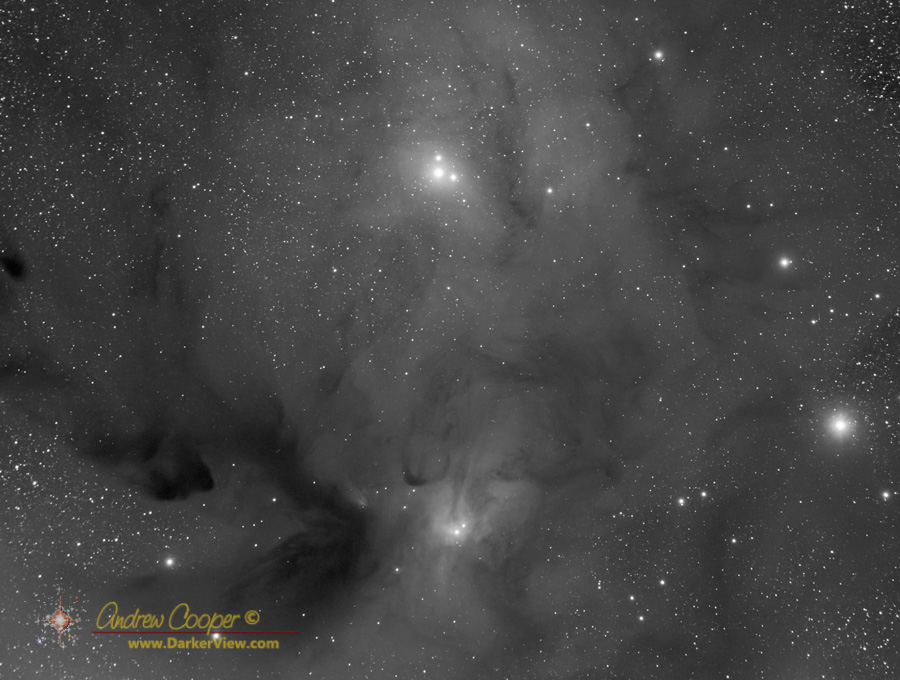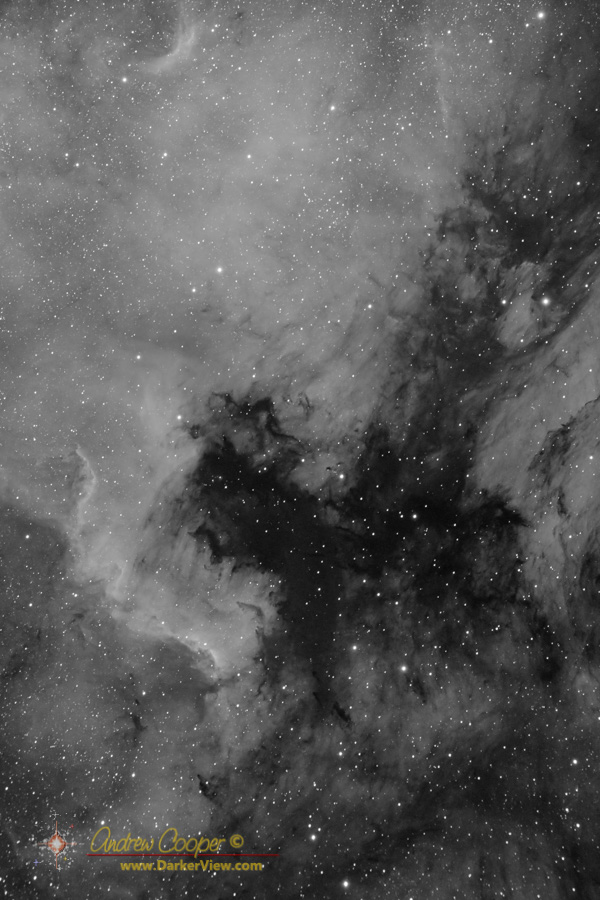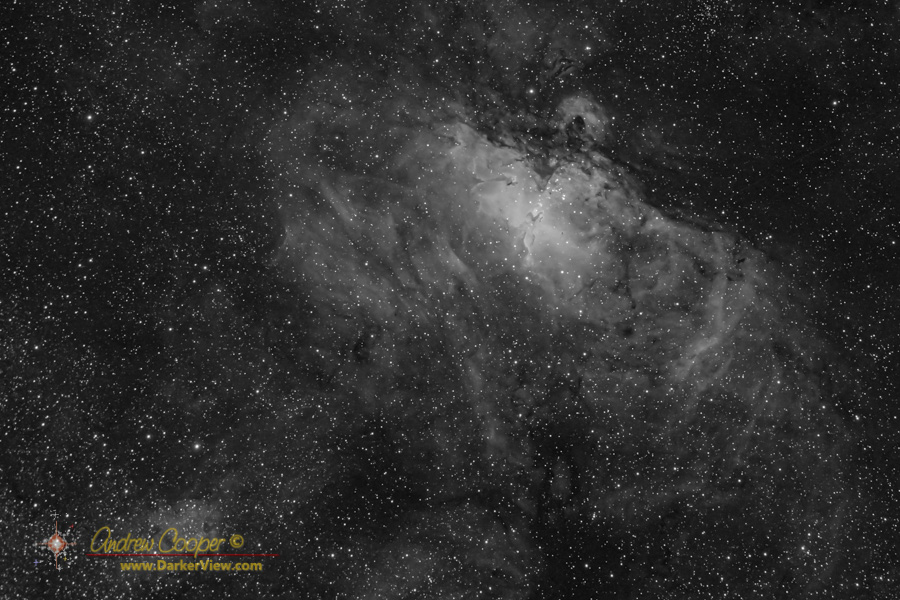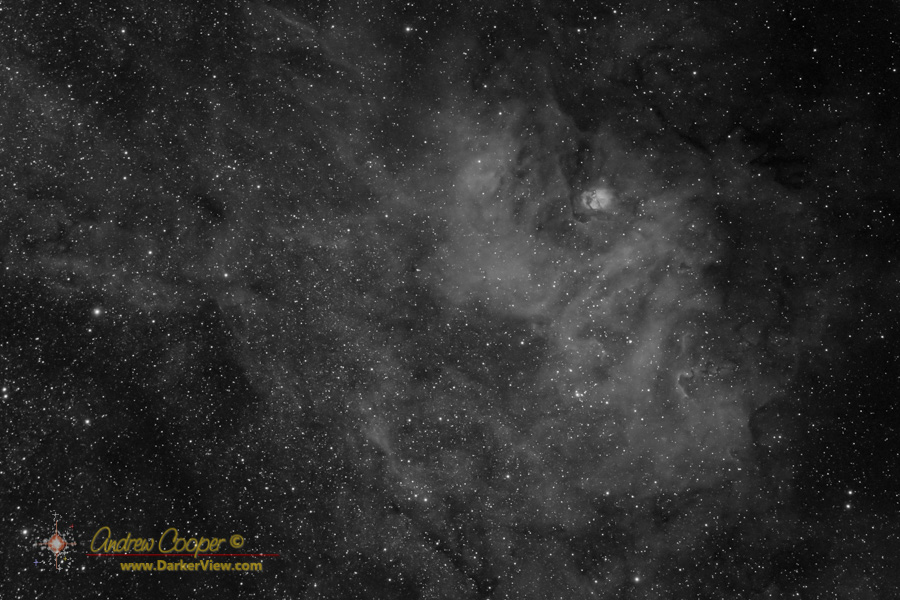
Rho Ophiuchi Region in Monochrome

When you want to see the stars, find someplace dark

Taking the AT6RC tube off and installing the Televue 76mm on the mount changes the game a bit. Lower magnification, wider field, a setup I find more appropriate for Waikoloa skies.
The average seeing in Waikoloa is 2 or 3 arcseconds, or worse… Not the 0.5 arseconds typical at the summit. This leads to mushy stars at higher magnification, fuzzballs rather than pinpoints. Lower magnification sidesteps this problem.
Still using the borrowed ASI2600MC color camera for a few more days, seeing just what it is capable of. The slightly larger sensor is nice and the data easier to process, but still I am seeing limitations that annoy me in the fine details. The color balance is difficult to deal with as well.
I will be going back to the ASI1600MM and filter wheel soon enough. I do need to up my processing game, the software side has changed substantially over the years and I need to transition. Will be giving PixInsight a spin over the next month.

NGC7000 or The North American Nebula is found in Cygnus, just northwest of the bright star Deneb. A huge complex of glowing gas and dark dust the nebula covers and area several times larger than the full moon.
The image here is the sum of 60 individual frames, 30 at 1 minute and 30 more at 5 minutes of exposure taken with a TeleVue 76mm scope and a ZWO ASI1600mm Pro camera through a hydrogen alpha filter.

To allow a wider field of view requires changing optics. In this case putting away the TV-76mm telescope and mounting a vintage Nikkor 180mm f/2.8 ED camera lens.
The Nikkor 180mm is a classic lens, once a favorite of professional film photographers for news and portrait work. Now the lens is out of date, not autofocus, or image stabilized, a bit of very good optics left behind by technology.
Of course, autofocus or image stabilization are useless for astrophotography. With a simple adapter the lens can be mounted to a modern system and used as a fully manual lens in an application where the excellent optical quality can still be appreciated.

The Rho Ophiuchi region is a confused mass of gas and dust just above Antares and the head of Scorpio. This extensive nebula complex is far larger than the single frame shown here, extending far to the east into Sagittarius.
Rho Ophiuchi itself is the triple star seen here at the top center of the image, at the center of a bright reflection nebula. The double at lower center is Iota Scorpii and the star Al Niyat is on the right side. Also notable are the dark clouds of dust and gas that block the light of the stars and nebula behind creating black voids in the starfield.
This area is quite colorful, with both the blues of reflection nebulae and the reds of emission nebulae. I have gathered some color data but need more before assembling a proper color image of this region.

I have been processing more images from this last week. This one is another classic nebula, the Eagle. The nebula, also known as M16 or NGC 6611 can be found in thick regions of of our galactic core towards the constellation of Serpens.
The eponymous eagle can be seen near the center of the brightest region, a structure of darker material likely held together by the gravity of objects inside it. In this case those objects would be forming stars, or protostars, the result of the dust and gas being drawn together under the influence of gravity.
I have a full set of color filters, once I have had fun re-doing many of these classic nebulae in hydrogen alpha I will probably begin doing full color versions. Color takes a lot more exposure time and much more processing. There are techniques to add H-alpha data to an RGB image to get more definition in the nebula structure, something I have not done and should probably figure out.

Next up is the Trifid Nebula in Hydrogen Alpha. This bright nebula is less than two degrees above the Lagoon Nebula as seen in the post a few days ago. Indeed, the bright wisps along the bottom of this shot are the northern bits of the Lagoon.
The Trifid, also known as M20 or NGC6514, is another stellar nursery where star formation is occurring as we watch. The dense gas and dust is being carved into a cavity by the stallar winds of these hot young stars within the nebula creating the bright core cut with dark lanes of dust that we see in this image.
To truly capture this region I need to take at lest one more frame of the area and put together the several resulting frames as a mosaic to cover this large and beautiful nebulae complex.

Sharpless 2-54 is an often overlooked nebula complex just 2° north of the far more famous Eagle Nebula M16. It is actually part of the same nebula complex the stretches from M17 through M16 to Sh2-54 and beyond. The nebula is much fainter, with not much appreciable without a camera attached to the telescope, thus the complex is not as well known.
The star cluster NGC6604 is found within the nebula, a collection of young stars recently formed from these clouds of gas and dust. In the photo here the cluster is seen just down and right of image center.
Again this image is taken through a hydrogen alpha filter to best show the wisps of glowing gas among the stars.
